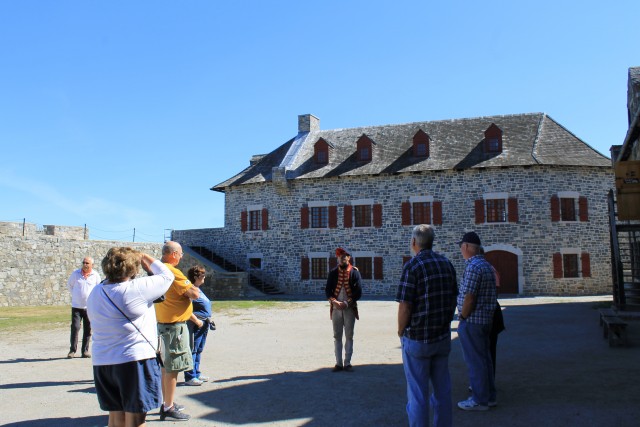There’s no doubt about it: Alexander Hamilton is a rockstar right now.
The Founding Father is the subject of the smash-hit Broadway musical “Hamilton: An American Musical,” which tells the story of the American Revolution and the early days of our country through a hip-hop lens. It has taken America by storm, selling out shows since its off-Broadway debut in February 2015 and only gaining steam when it moved to Broadway in August 2015. It’s been raking in awards all year, seeing references to it throughout pop culture, and in March, the cast was invited to perform selections from the show at the White House.
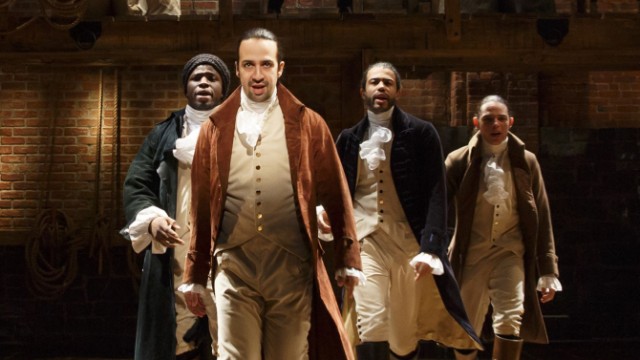
It’s next to impossible to get tickets for the show, which Lin-Manuel Miranda wrote and until recently starred in the title role. I am a Hamilton devotee, listening to the original Broadway cast recording almost daily, and I’ve been scheming with a friend about how to make sure we can get tickets to see the touring production when it comes to Boston in 2018. Yep, that’s two years from now. That’s what I mean when I say it’s impossible to get tickets.
Learning from Hamilton
Though the musical isn’t 100 percent historically accurate, it has been getting people interested in the stories of the people who built America. So with all that popularity, it makes sense for those who regularly promote American history to grasp onto it to help tell their stories. Fort Ticonderoga was getting requests to borrow their Hamilton-related artifacts when they realized they should take advantage of what they had, and they put together an unplanned exhibit that focuses on Alexander Hamilton, which you can visit for a limited time — it closes Oct. 30.
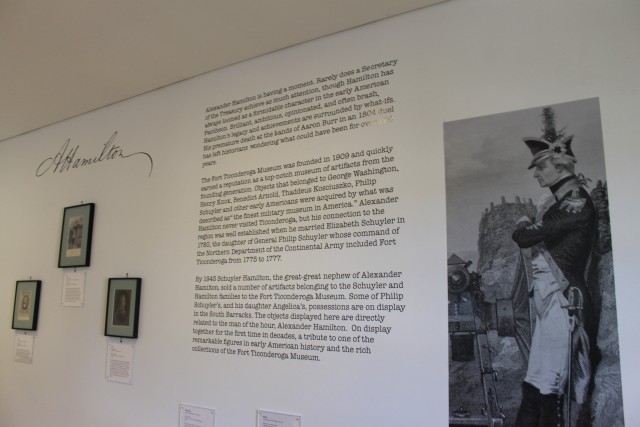
Hamilton, who lived from the mid 1750s (there’s some dispute over his actual birth year) to 1804, never visited Fort Ticonderoga. But he did have ties to it. Hamilton married Elizabeth Schuyler, whose father, General Philip Schuyler, commanded the Northern Department of the Continental Army, which included Fort Ticonderoga, from 1775 to 1777.
Alexander Hamilton’s great-great-nephew, named Schuyler Hamilton (they weren’t very creative with names, huh?), sold a group of Schuyler and Hamilton family artifacts to the Fort Ticonderoga Museum.
Artifacts
And that’s how the museum came into possession of a handful of Alexander Hamilton-related artifacts. They have on display a sword that has Hamilton’s name inscribed into its handle, right next to a regal eagle head at the base of the sword. There’s also a sword knot with “Genl A. Hamilton” written on it in ink. (Reminiscent of “A-dot-Ham” in the song “Your Obedient Servant,” no?)
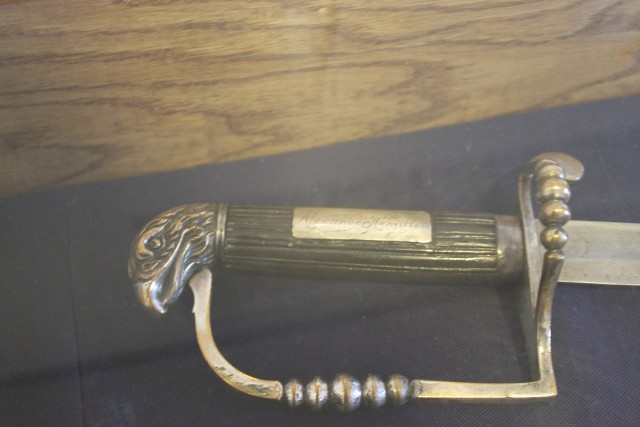
Anyone familiar with the musical knows that Hamilton craved a chance to fight in the revolution, from the second song when he’s new in New York and tells Aaron Burr, “God, I wish there was a war! Then we could prove that we’re worth more than anyone bargained for,” through the time when Hamilton serves as Gen. George Washington’s right-hand man in the war:
“Hamilton: And ev’ry day, ‘Sir, entrust me with a command.’ And ev’ry day,
Washington: No.
Hamilton: He dismisses me out of hand.”
So it’s really cool to see physical evidence that he ended up in fighting as a general. Hamilton may have even carried the sword in late 1799 when, after Washington died, Hamilton was the highest-ranking military officer in the U.S.
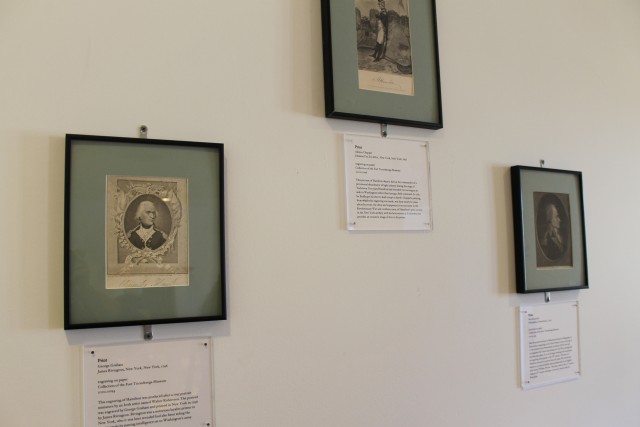
There’s also some contemporary images, including one of Hamilton at battle, as well as an epaulet, which is a a piece of fabric that officers wore at war to distinguish themselves from enlisted soldiers. According to the press release announcing the exhibit, “It is unknown whether the epaulet was originally part of a pair. If not, it may date to Hamilton’s earliest service in New York in 1777.”
Probably my favorite item on display, though, is a mahogany writing box that belonged to Alexander. It’s inscribed with “Alexander Hamilton, Yorktown, October 19 1781.” The inscription alludes to the Siege of Yorktown, referred to in the musical as the Battle of Yorktown, which was when Hamilton was finally put in charge of three batallions after he and his friends spent years badgering Washington to give him troops to command. Yorktown was also effectively the end of fighting for the American Revolution. The musical chronicles the battle in "Yorktown (The World Turned Upside Down)."
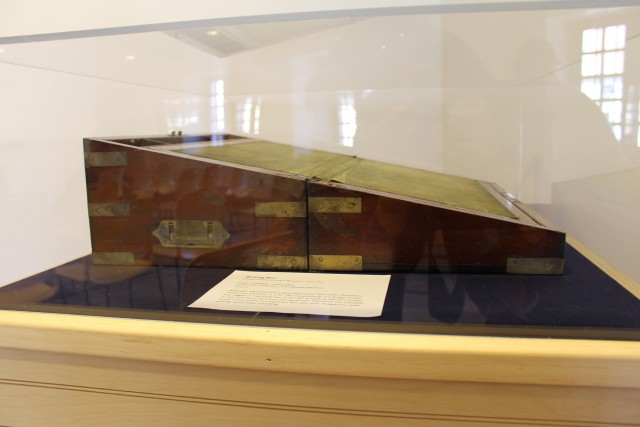
But beyond the importance of Yorktown, anyone familiar with Alexander Hamilton knows how important writing was to the first Secretary of the Treasury’s entire life and career. In the song “Hurricane,” Hamilton talks about all the ways he has relied on the pen over the years, starting with the letter he wrote that encouraged elders in his small Caribbean village to raise money to send him to the mainland:
“I wrote my way out of hell
I wrote my way to revolution
I was louder than the crack in the bell
I wrote Eliza love letters until she fell
I wrote about The Constitution and defended it well
And in the face of ignorance and resistance
I wrote financial systems into existence
And when my prayers to God were met with indifference
I picked up a pen, I wrote my own deliverance”
So to see a desk right in front of me where he actually wrote some of his world-changing letters, papers, and essays was just... breathtaking. What an awesome experience.
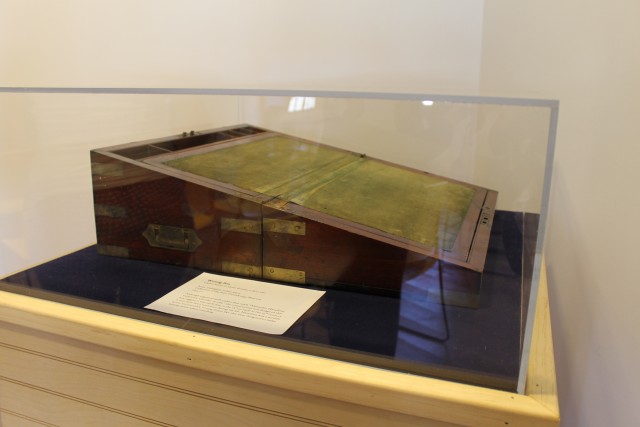
It’s kind of funny that it’s a portable writing desk, since Burr asks Hamilton in the song “Non-stop,” “Why do you write like you’re running out of time? Write day and night like you’re running out of time?” Hamilton could bring this desk with him anywhere and get some writing done, regardless of where he was traveling!
Angelica's possessions
Besides the artifacts that belonged to Hamilton, there are other pieces that might ring a bell for anyone into the musical or other Hamilton aficionados. In the Fort’s South Barracks exhibition space, there’s a section of Philip Schuyler’s artifacts.
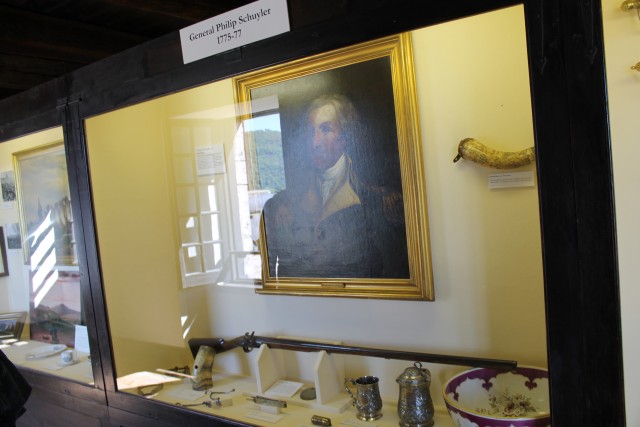
Included here are two possessions belonging to Hamilton’s sister-in-law Angelica: a locket containing a four-leafed clover, and a seal inscribed with her name that she would have used on letters she wrote.
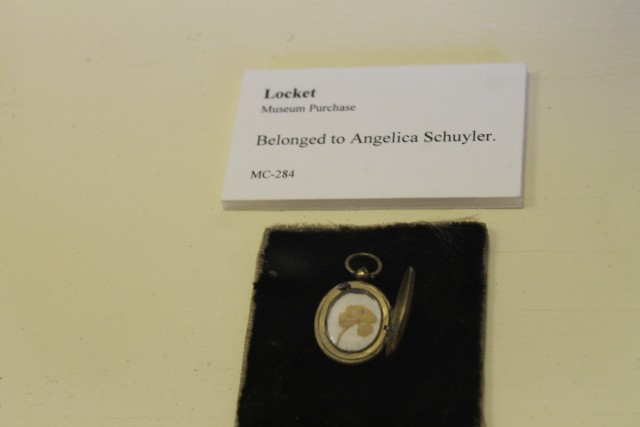
One of the principle relationships covered in the musical is Hamilton’s with Angelica. In real life, Angelica was already married when the two met, but in the musical, Angelica and Eliza are both single, and Angelica realizes upon meeting Hamilton at a ball that although she immediately has feelings for him, being with him won’t allow her to climb the social ladder as she feels she must. This leads her to introducing Alexander to Eliza, who also immediately falls for him.
Despite Alexander marrying her sister, Angelica maintained a strong, flirtatious relationship with her brother-in-law, both in the musical and in history. Historians argue over whether the two actually had an affair or whether they kept it to overly affectionate letters, but there’s no doubt that the two are taken with one another and are on the same page intellectually, more so than with either of their spouses.
Miranda includes some of both the intellectual/political advice and affection in his versions of the letters Angelica would write to Hamilton:
“My dearest Alexander
You must get through to Jefferson
Sit down with him and compromise
Don’t stop ‘til you agree
Your fav’rite older sister
Angelica, reminds you
There’s someone in your corner all the way across the seaIn a letter I received from you two weeks ago
I noticed a comma in the middle of a phrase
It changed the meaning. Did you intend this?
One stroke and you’ve consumed my waking days
It says:
‘My dearest Angelica’
With a comma after ‘dearest.’ You’ve written
‘My dearest, Angelica.’”
Miranda says that though this passage is not a direct quote, it’s based on actual letters between the siblings-in-law. It’s cool to think of Angelica writing this, then putting her seal on the envelope as she mails it off across the sea.
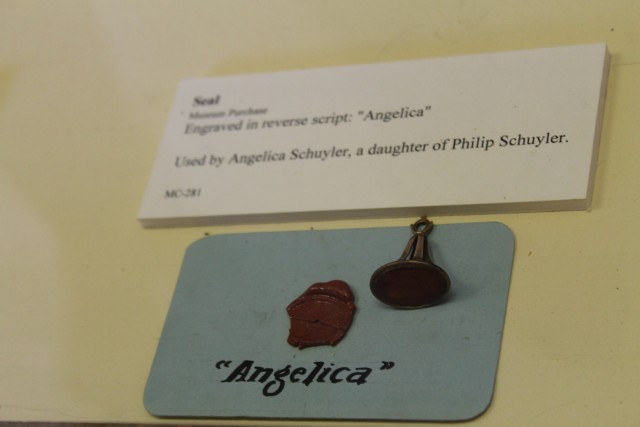
Making a connection
I loved seeing Hamilton’s (and Angelica’s) personal items and being able to make a personal connection to them. That’s the entire goal of the musical, using modern language, music, and casting that prefers racial minorities to white actors to help tell the story of America back then to America today.
And seeing actual items the characters used in front of your face — it turns them from characters you can read about in a book or see on stage to people who actually lived, wrote, fought, and who we should continue to learn from.
More at the Fort
And don't get me wrong, I was pretty enthralled with these few pieces, but there's plenty more to see and do at Fort Ticonderoga. Check out the Heroic Corn Maze this fall, or come visit for the Heritage Harvest and Horse Festival. Or just come explore the other exhibits and chat with the 1777 German, Canadian, British, and American soldiers and tradespeople working around and patroling the fort.
